When Southampton’s Parrish Art Museum decamped to the sprawling, stylized concrete potato barn in Water Mill it now calls home, the question arose as to the fate of its former abode on Jobs Lane. Many speculated it would shutter, leaving a cultural black hole in the center of downtown Southampton.
Instead, the renamed Southampton Arts Center has over the past two years opened its doors to outside curators and has become an important new participant in exhibiting and publicizing the continued vibrancy of the local artist community on the East End.
This is particularly apparent in the current exhibition, “East End Collected2,” curated by the painter Paton Miller, who organized the first incarnation of this exhibit last year. “East End Collected2” features more than 30 local artists working in myriad mediums and styles, and there is a remarkable vitality to the manner in which the pieces are arranged. This curatorial sensibility is further enhanced by the elegance and historically-steeped ambiance of the stately venue itself.
It should be noted that, to some degree, the title of the exhibit is slightly disingenuous, as the original intent was to present only works of artists culled from private collections. Instead, according to Miller, a little more than a third of the artists were hesitant to borrow from those who had previously bought their work, and instead gave pieces either from their own stock or from the inventory of their individual dealers.
While there are a number of truly interesting and remarkable pieces in the exhibit, the most engagingly dynamic in this critic’s view is Charles Waller’s Ball and Chain (mixed media) from his series of works using antique wedding dresses collaged onto canvas. (Full disclosure: I wrote a catalog essay about these paintings when others from the same body of work were shown at the Spanierman Gallery in East Hampton about 10 years ago).
.
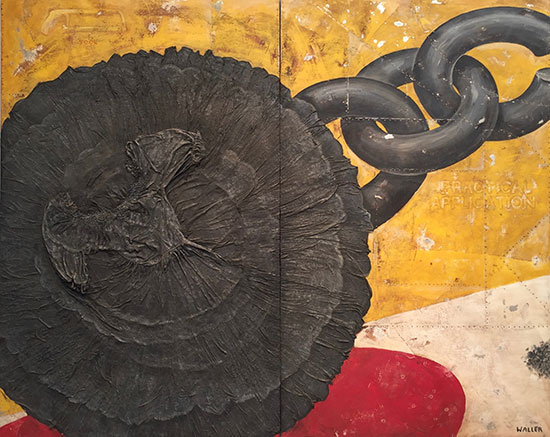
"Ball and Chain" by Charles Walker. Mixed media.
.
In the Southampton Arts Center exhibit, the artist uses a dizzyingly compelling overhead perspective to conjure a powerful sense of ghost-like movement, as if the gown were twirling and dancing to an unheard melody. Adding to the impact of the work, the inclusion of painted chains and images of hack saws introduces a whimsically dark sense of humor to the composition.
Mark Seidenfeld also uses a form of sardonic humor in his series of photographs. Mermaid and Fisherman (pigma print) calls to mind the Fellini-like atmosphere of David LaChapelle’s photo work. There are also aspects of Magic Realism in Seidenfeld’s use of surreal elements as an ordinary component in an otherwise commonplace environment.
.
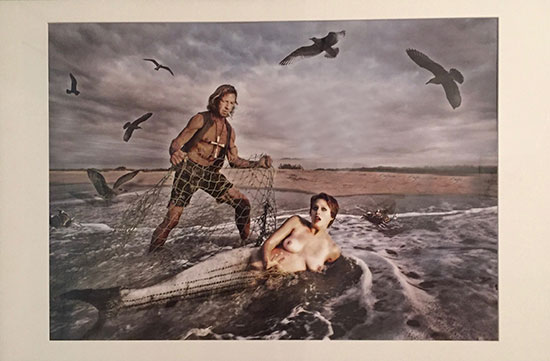
"Mermaid and Fisherman" by Mark Seidenfeld. Pigma print.
.
Interestingly, David Slater’s Ghost Ship and Garden of Eden (both acrylic mixed media) also establish an atmosphere of surreal whimsy although he creates a more ambiguous storyline in the painterly manner in which he organizes the surface of the work.
.
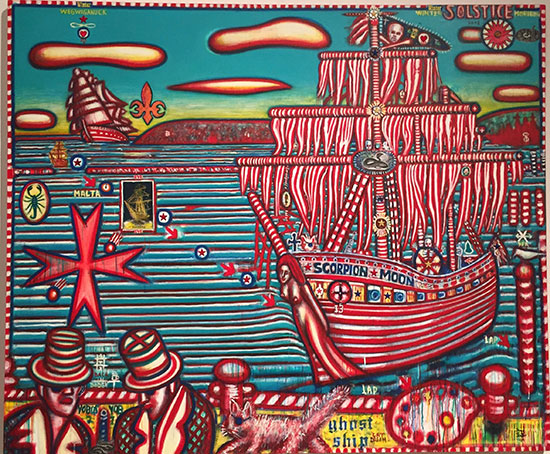
"Ghost Ship" by David Slater. Acrylic, mixed media.
.
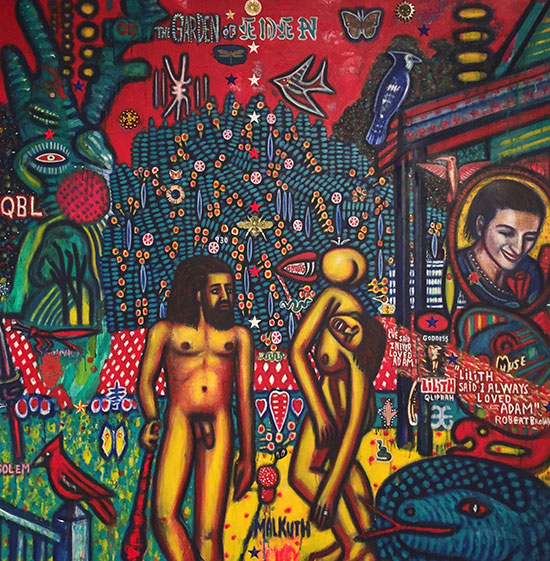
"Garden of Eden" by David Slater. Acrylic, mixed media.
.
While highly reminiscent of artists from the underground comic movement of the 1960s and ’70s, such as S. Clay Wilson and the East End’s own David Geiser, Mr. Slater’s use of collage components creates an atmosphere that prompts the viewer to continually search for clues as to how to “read” the work. The impulse is to somehow divine the narrative the artist has conjured, which is usually both highly political and marginally hallucinogenic.
While Mr. Slater introduces as much information as can be included in his compositions, Dalton Portella strives for a decidedly more minimalist approach, as evidenced in Blue Turn (watercolor, 2015). Constructing the image of a shark turning as if moving to unheard music in an undersea ballet, the work gains in impact from the artist’s powerful use of negative space to hint at the spectacular scope of the predator’s aquatic theatrical amphitheater.
.
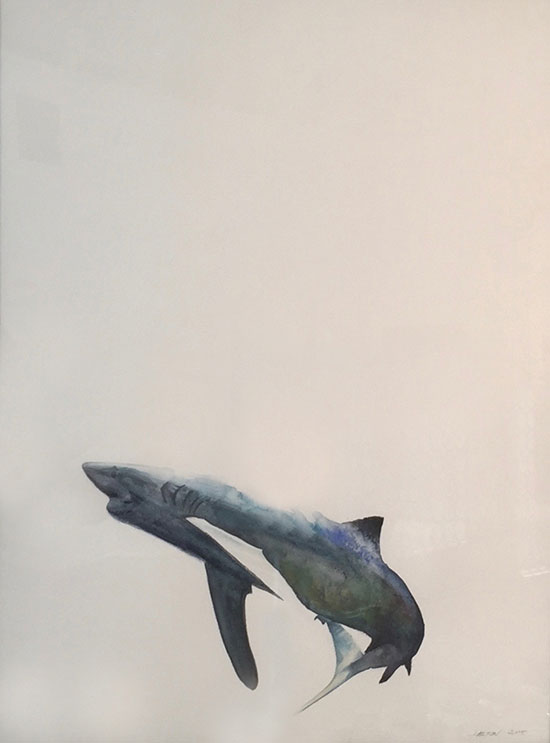
"Blue Turn" by Dalton Portella. Watercolor.
.
A graceful use of negative space and an elegant sense of motion are also important elements in Will Ryan’s Blue Wave (encaustic, 2005) which also highlights this artist’s masterful use of rhythmically delicate blue coloration. Conjuring an ineffable measure of harmony and tempo through his simple flow of brush strokes, it is almost impossible to look at this work and not hear strains of flowing jazz-like echoes as one’s eyes are drawn across the surface of the painting.
.

"Blue Wave" by Will Ryan. Encaustic.
.
Also of particular note in the exhibition are Hans Van de Bovenkamp’s Mayan Garden (bronze), Karyn Mannix’s Lips (oil), Ned Smyth’s Torso Cliff (color print, 2014), Peter Dayton’s Stella #18-Devil Surf (gesso and resin on wood) and Nico Yektai’s Bench #12 (cherry).
To see the works mentioned above, view our slideshow:
_____________________________
BASIC FACTS: “East End Collected2,” curated by Paton Miller, is on view May 5 to June 12, 2016 at the Southampton Arts Center, 25 Jobs Lane, Southampton, NY 11968. www.southamptonartscenter.org.
_____________________________
Copyright 2016 Hamptons Art Hub LLC. All rights reserved.
